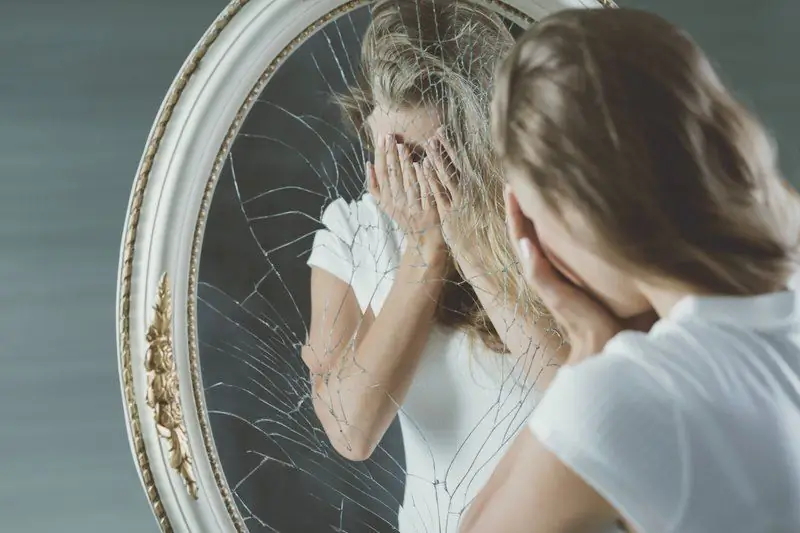
Table of contents:
- Author Bailey Albertson [email protected].
- Public 2023-12-17 12:53.
- Last modified 2025-01-23 12:41.
Why you can't look a cat in the eye

Even in ancient times, people avoided direct eye contact with a cat, believing that this could cause unhappiness. Scientists later confirmed that clashing eyes with a predator is really dangerous, but for a different reason. However, much depends on the circumstances and nature of the animal, so there is no reason to be afraid of pets in most cases.
Content
- 1 Feline eyes and mysticism
- 2 Is it possible to look a cat in the eye scientifically
- 3 What to do if you accidentally make eye contact
- 4 Personal experiences of pet owners
Feline eyes and mysticism
Cats have long acquired an ambiguous reputation as the most mysterious animals. They are credited with a lot: the ability to predict natural disasters, healing abilities, the ability to resist corruption, etc. Attitudes towards pets have changed over the millennia and depended on the region, local customs and even the profession of people. For example, if the majority believes that a black cat portends trouble, then sailors try to take such an animal on board in order to attract good luck. Fishermen's wives also often pick up pets with a dark fur coat: many believe that a pet is able to save the owner from accidents on the high seas.

In the form of a red cat, Ra defeats the snake Apopa - the personification of darkness, evil and chaos
Cats were alternately associated with the gods, then with the devil. In ancient Egypt, pets were considered sacred. Perhaps the animals earned such a high status due to their ability to catch rats and mice. This helped the Egyptians to save the harvest. The supreme sun god Ra was often depicted as a ginger cat. The image of a cat was also given to the goddess Bastet, who symbolized fertility, motherhood and joy. In the city of Bubastis, a cat temple was erected, in which a holiday in honor of Bastet was annually celebrated. An animal cemetery was discovered near the sacred site. The pets were buried with all the honors: rich owners mummified bodies, equipped special tombs, and even left several mice next to the cat so that the pet would not suffer from hunger in the afterlife. The murder of a fluffy mouse-catcher was punishable by execution, and after the death of the animal, all family members wore mourning and even shaved off their eyebrows. It was forbidden to take cats out of Egypt.

Archaeologists have found many finds that confirm that the Egyptians treated cats with respect and even equated them with demigods.
Cats came to Europe from Egypt. At first, the mouse-catchers were treated with great respect. The cost of a kitten could exceed the price of a lamb, and adult cats were even more expensive. The inhabitants of the British Isles believed that the mouse catchers accompanied the fairy queen Mab. On the territory of modern Germany, it was believed that cats serve the goddess of beauty and love Freya. In Medieval Europe, furry favorites were declared Satanic accomplices. The Inquisition emphasized that cats have the same differences that are attributed to representatives of dark forces: sharp claws, night vision, glowing eyes, etc. Animals were brutally exterminated. Cats, along with their owners, were ruthlessly killed. The pets were strangled, thrown from the towers, burned, walled up in the walls and buried alive.

In the illustrations, Freya was often depicted on a chariot drawn by cats
Friendship with cats was renewed during the Enlightenment. Some rulers kept cats at court, which risked incurring the wrath of the church. In the 17th century, the wife of the French king Louis XV, Maria, even arranged ceremonial funerals for the deceased pets. On the territory of modern Britain, the pursuit of cats was prohibited at the legislative level. The mass extermination of animals ended in the 18th century.
If in Medieval Europe looking at a cat could cost life, now there is no such threat. However, many people still prefer not to bump into little mice. It is believed that cats are connected with the other world, can communicate with the dead and are even able to predict the future. Some people believe that by looking at an animal, you can find the answer to any question. If, after sounding it, the pupils of the pet narrowed, the person will be able to achieve success in his endeavors. Slightly closed eyes are a particularly auspicious sign. Dilated pupils indicate that the questioner should postpone the planned tasks. Closed eyes are perceived as a harbinger of complete failure. A dream in which a person saw a cat's gaze can mean unpleasant surprises in the future.
Since cats are sometimes still associated with evil spirits and endowed with magical properties, people have established a kind of prohibition on eye contact with animals. Among the main reasons for this taboo is the ability of pets to steal life, happiness and sexual energy from their owners.
Can you look a cat in the eye scientifically?
It is much easier to explain taboos and fear of cats scientifically. With direct eye contact, the animal feels threatened and becomes aggressive. This is due to the special structure of the organs of vision, which is strikingly different from the human.

The lack of understanding between humans and cats may also be due to the fact that round pupils in the latter indicate the presence of unfavorable factors, while for humans, round pupils are the norm.
A cat does not need to concentrate on one subject to control its surroundings. She has peripheral vision, thanks to which the animal can easily notice what is happening around, even if for a long time it looks like it looks like nothing. This is easy for cat owners to check: try, at the moment when the pet is relaxed, to stand on its edge of the field of view and get out a favorite toy or a bag of food. This should be done silently and without unnecessary movements. Both of my cats react to this instantly, even if they are busy playing with each other or almost fall asleep.

Due to the location of the eyes, cats are even better at seeing what is happening to the side of them than what is directly in front of them.
Pupils in cats change shape depending on how far away the object that attracts their attention is. Narrowing occurs when the object is close. Also, the size of the pupils affects light perception. The surface of the cat's eyes is covered with a layer of special cells - tapetum. It resembles a mirror in its properties and reflects light, which allows animals to see better in the dark. The darker it is in the room, the more the pupils of the pets dilate to catch more rays.

In fact, in terms of reflecting rays, we are not so different from pets: you just need to remember the red-eye effect in the photo, which appears due to the flash; just human eyes need more light
Although it seems to us that cat's eyes glow in the dark, it is just a reflection and play of light. It's easy to check: try bringing your pet to the bathroom, for example. In a completely dark room, there is no light, there is nothing to be reflected, so the cat's eyes will not glow either. Another indirect evidence is a different shade when reflected. It depends on the pigment contained in the tapetum. The most common color is green or yellow, but other variations are possible. For example, my sister has 2 Siamese cats. In representatives of this breed, eyes glow crimson in the dark.

Normally, in a relaxed cat, the pupils have the shape of a narrow ellipse, and the eyes are half-closed.
Most often, cats focus their gaze on a specific object during a hunt or conflict with another pet. Sometimes this behavior is associated with other intentions. For example, curiosity, fear, sexual desire, etc. Cats can communicate with a glance about their love for the owner, but this happens even less often and, as a rule, the animal does not look directly into the eyes at such moments. It is for this reason that direct eye contact among predators is undesirable. It is associated with aggression and anxiety, and can also mean the beginning of rivalry. Prolonged contact will provoke the cat to attack.

If the cat wants to avoid an attack, she will arch her back: this helps her to appear larger and stronger.
Dilated pupils and gaze indicate that the cat is under stress. Her behavior is focused on the full mobilization of forces. Dilating the pupils allows you to capture more light and gain an advantage in a possible collision, and a gaze is necessary to observe the actions of the subject. Sometimes cats fight with their eyes alone. For example, my favorites during the period of acquaintance often sat in front of each other and looked carefully. Thus, they sorted out the relationship: they tried to determine the hierarchical status of each. If it came to hiss and light whipping, then only after a few minutes. The one who looked away, gave up and lost in advance. It was obvious from the outward appearance of the favorites that they were tense. Cats froze in one position, could bend to the floor, the tip of their tail darted from side to side. Before the attack, they pulled their ears back and bared their teeth.
What to do if you accidentally make eye contact
Occasional direct eye contact with a pet is usually not bad at all. Cats gradually get used to the behavior of their owners, so they stop perceiving the look as a sign of aggression. The situation is different with street animals and pets that are not fully adapted.

We do not recommend checking how patient your cat is: even the most peaceful animal can become aggressive with prolonged eye contact if it is not used to it
If you notice that the cat has fallen on its front paws, moves its tail down and is heading towards you, it is better to step back and break eye contact. Most often, this is sufficient to prevent an attack. If the cat does not stop, you need to use available means of protection. Pieces of thick cardboard, clothes, etc. will do. You can scare your pet and temporarily eliminate the threat with water.
Offensive aggression is less common in cats. More often they defend themselves out of fear. In nature, even a small wound can cause death, which is why cats prefer to avoid open collisions. Increased irritability and direct aggression can indicate a critical level of stress and illness, so it is recommended to show your pet to a veterinarian or zoopsychologist if problems arise.

Never try to pet or calm an angry cat; this will only increase irritation and anxiety.
You can understand how the cat is tuned by movement and gaze. With offensive aggression, the pupils of animals become narrow. If the pet is alarmed or frightened, they expand. The latter is more typical when eye contact with a person occurs, since we can pose a threat to cats due to the difference in size. When defending, the pet can sneak, curl its tail and ears, hiss and strike quickly with its paws. At the first sign of fear, it is enough to do the same as in the case of aggression: break eye contact and retreat without making sudden movements.
If you still could not avoid the attack, it is advisable to expose the most protected parts of the body to the cat. Most often, the animal has no intention of killing the enemy. The fight ends after receiving several bites and scratches, as well as the retreat of the opponent. Do not pull the cat away by force, as this will increase tissue damage. This can only be done if the animal grabbed you, for example, by the jacket and did not bite through the skin. You can cover the cat with a cloth to make it confused and retreat on its own.

Due to the structure of cat teeth, pockets remain in wounds that are difficult to heal and easily become infected; wounds inflicted on animals are very painful, adjacent tissues swell, when infected, purulent contents can be released
When receiving wounds, it is necessary to provide first aid to the victim: rinse the damaged area with running water and soapy water and treat with chlorhexidine or hydrogen peroxide. It is advisable to use laundry soap, as it contains more alkali. Rinsing should last for 5-7 minutes. The water should be at a pleasant temperature to the body: cold liquid will ease infection, and hot water will increase inflammation.
After processing, apply a clean gauze bandage. It is forbidden to use a patch. It blocks air and causes wound decay. You must consult a doctor within 24 hours. He will conduct an examination and give vaccinations if there is a threat of infection. It is important not to hesitate to visit the hospital, as bacteria from the wound can enter the heart tissue. When infected with rabies, pathological changes appear after 3 days. Antibiotics are often prescribed to patients to facilitate wound healing and prevent the spread of pathogens.
Personal experience of pet owners
Eye contact with a cat can be dangerous if the animal is initially irritated or has no experience with humans. In such cases, it is recommended to avoid further exacerbation of the conflict, since the pet can cause serious injury when attacked. Pets gradually get used to human means of non-verbal communication, so they are more tolerant of direct gaze.
Recommended:
Why You Can't Look In The Mirror When You Cry

Superstitions regarding tears in front of a mirror. Where did they go, logical explanation
Why You Can't Why You Can't Wash Floors On Friday: Signs And Facts

Why you can't wash floors on Friday: signs and superstitions. The opinion of the mystics and Orthodoxy
Why You Can't Look In The Mirror Together, Especially For Girls: Signs And Superstitions

Why you can't look in the mirror together, especially for girls Since ancient times, inexplicable magical powers have been attributed to the same things. Mirrors occupy a special place among such items. It is generally accepted that they connect the real world with the other world.
That You Can't Look By Signs And Common Sense

That one cannot look by signs and common sense, so as not to incur misfortune
What Are The Signs To Understand That You Are A Real Friend, With Whom You Can Go Into Fire And Into Water

How to understand that you have a real friend who will not leave in trouble
